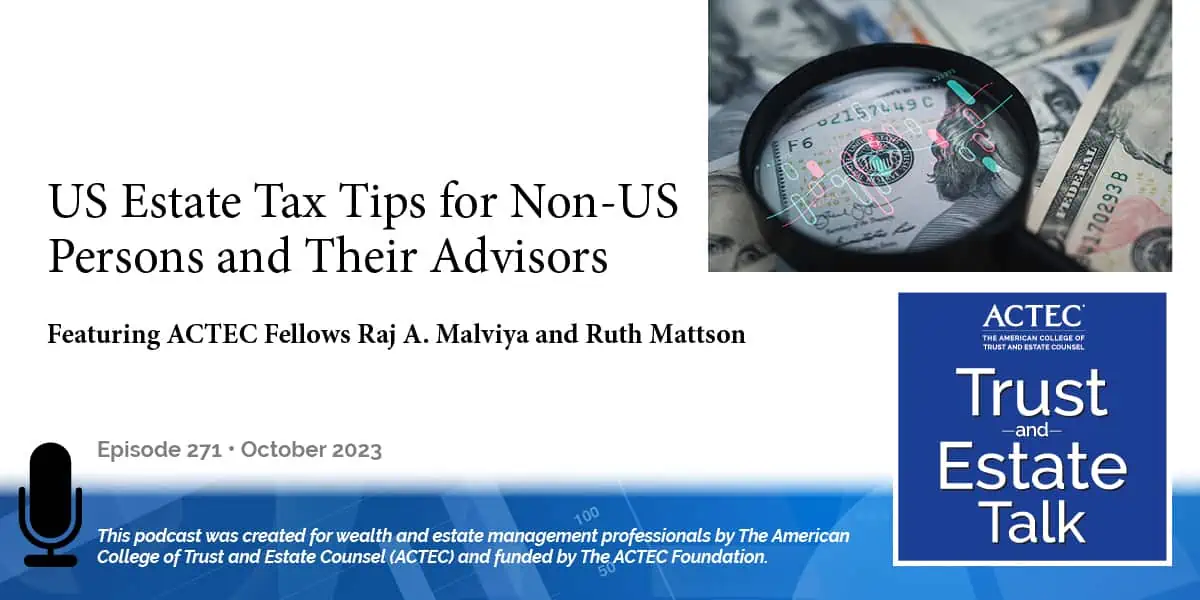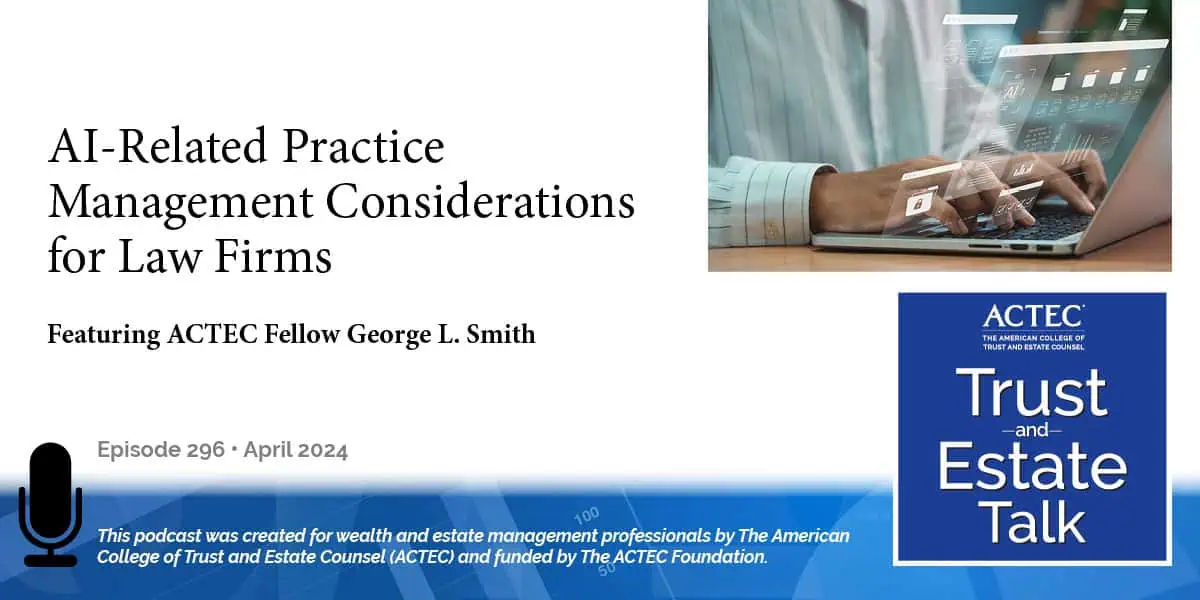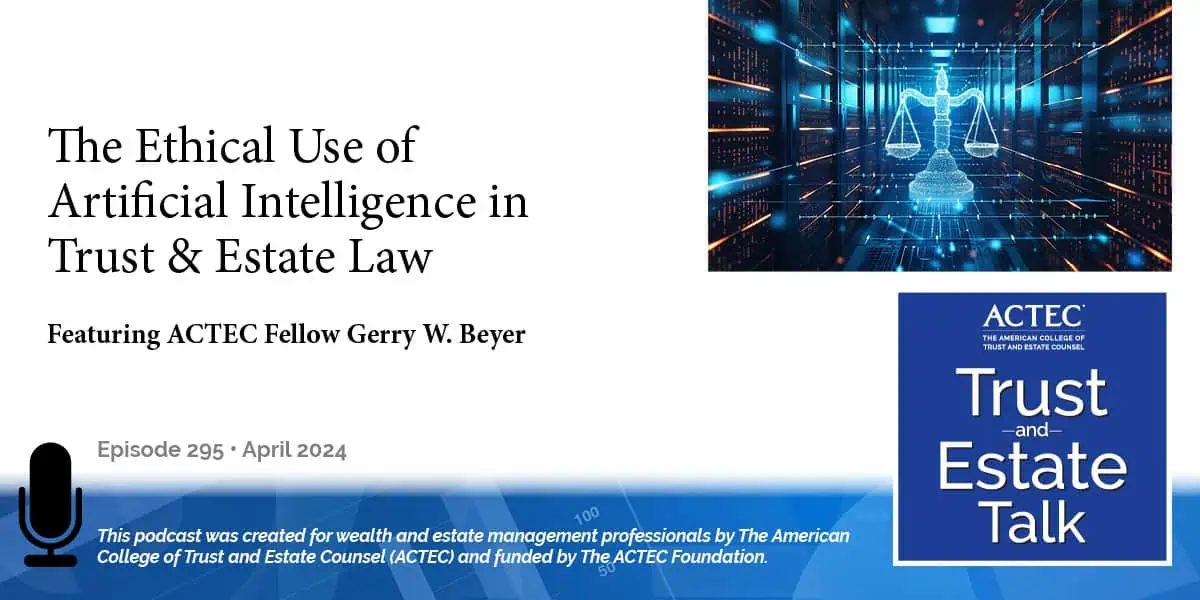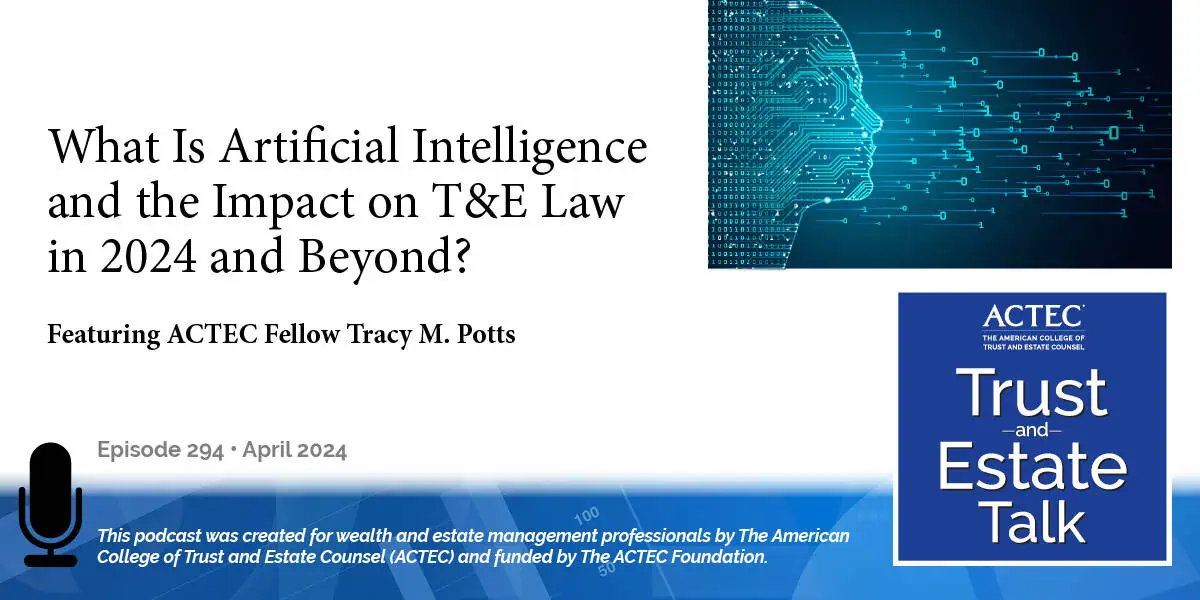US Estate Tax Tips for Non-US Persons and Their Advisors

“U.S. Tax Tips for Non-U.S. Persons and their Advisors,” that’s the subject of today’s ACTEC Trust and Estate talk.
Transcript/Show Notes
This is Doug Stanley, ACTEC Fellow from St. Louis, Missouri. Non-U.S. persons have unique, and sometimes, unexpected estate tax requirements. ACTEC Fellows Raj Malviya of Grand Rapids, Michigan, and Ruth Mattson of Boston are with us today to break it down and offer tips.
Defining Non-U.S. Persons
Ruth Mattson: Thank you, Doug. Well, the first thing we have to identify is who is a non-U.S. person for U.S. estate tax. This is going to be the same analysis that we do for gift tax, it’s going to be not a U.S. citizen, not domiciled in the U.S. And this is very important because the tax forms use the term “nonresident,” but the definition for estate tax is a domicile definition. It’s entirely separate from the income tax definition. It does match the gift tax definition, so a non-domicile is nonresident for gift and estate tax purposes.
Filing Requirements and Taxable Assets for Non-U.S. Persons
Now when you have somebody who you identify as a non-U.S. person, they’re going to be filing Form 706-NA. It’s a different tax form, and they’re going to file it as soon as they have reportable property that exceeds $60,000. So, it’s important to do this analysis and find out if you’ve got somebody who’s not a U.S. person. They may have to file when you didn’t expect any U.S. estate tax issues.
Now that we’ve identified who is a non-U.S. person, we have to look at what is taxable in a non-U.S. person’s estate. The tax code refers to U.S. situs property. That’s what’s going to be taxable in the U.S. But of course, that’s a defined term. The code has several specific definitions about what is and is not U.S. situs.
What is U.S. situs? All stock in a U.S. corporation is going to be subject to U.S. estate tax in the hands of a noncitizen, nonresident. All real property and tangible property that’s situated in the U.S. is going to be included in the estate tax. Also, all debts and contracts issued by or enforceable against U.S. persons. Basically, if a U.S. person owes money to the nonresident, then that’s included in the taxable estate.
Excluded Assets for Non-U.S. Persons
There are a few things that are excluded. So, life insurance is excluded from the U.S. estate. Bank deposits, if they’re in a U.S. bank- not a brokerage house, but a bank– those will be excluded from the taxable estate. Also, portfolio debt. If the debt had tax-exempt interest while the person was living, then it’s excluded from the U.S. estate tax at death. And now I’ll turn it over to Raj.
Raj Malviya: Thanks, Ruth. And just to follow up on that last summary of asset situs and classification, it’s not always intuitive. And you listen to some of the examples that Ruth gave, where you might instinctively think this asset has a U.S. situs, but it’s not. Life insurance and depository accounts in a U.S. bank, are examples where you really have to exercise some caution and understand the decedent’s balance sheet. And where the assets not only are located physically but also the type of asset, to make sure that you have the right classification as U.S. situs or not for U.S. estate tax purposes. So, I just want to reinforce that point. I think it was well stated and that is a nice segue into the administration side of a non-U.S. decedent.
Estate Tax Return Filing for Non-U.S. Decedents
And what we’re really talking about here is, that we have a decedent who is not a U.S. citizen, and not a U.S. resident under the domicile test that Ruth mentioned for U.S. estate tax purposes. And if we have that fact pattern, then what we’re going to be looking at is a possibly, estate tax return filing for the nonresident decedent.
We start with the classification, as Ruth mentioned, and then the total value to see if we exceed that $60,000 threshold, but the analysis does not end there. As we will talk about in a moment, there might be some relief under different estate tax trees between the decedent’s domicile country and the United States. But before we get to those pieces, let’s just talk about the process, and just some logistical administrative items.
The first thing we’re going to need is a tax ID number, aka an ITIN, for the nonresident decedent. To secure a tax ID number for the estate of a nonresident decedent, we typically start with the form SS-4, which is what the executor would file in order to obtain a tax ID number from the IRS. It not only helps with the filing of the estate tax return but also the income tax return for the nonresident estate. And that form is going to be a 1040 because there is no such form as a 1040-NR at this point.
But even an easier way these days to get an estate ITIN number is to use the online application process that you can find on the IRS website. The problem, though, is that’s easier said than done. A lot of practitioners in the international space who handle the nonresident decedent administration are having difficulty getting tax ID numbers for NRA decedents. And that’s just because there’s a roadblock once you get to a certain point in the online application and you do not have a social security number.
You don’t have one for the decent because the decent was a nonresident and never had a reason to file for a social security number, and you don’t have an executor who’s willing to list the social security number for himself or herself. So, what do you do? And this is more of a survey in the international practice community. Some have been able to secure SS-4s– or I should say, excuse me, ITIN numbers– by completing the SS-4 and then calling an IRS hotline for the International Division. Others have had success using banks of numbers that they’ve fortunately had for quite some time. And so, there’s just a little bit of a roadblock in that scenario.
But you need a tax ID number for the estate to get to the next step. And that’s preparing the compliance forms necessary, whether that’s an estate tax return or what’s called a transfer certificate application. So, after we get the ITIN, who’s really in charge of getting that information and then signing off on the compliance? And that’s going to be the executor. We know what the term executor means. Hopefully, we have a designated one in the estate plan documents or the will.
But if there is no last will and testament, or no nomination of an executor or administrator appointed, what we’re going to need to do is look at the statutory definition of executor, and that’s found in Chapter 11 of the code under the 2203 Regs. And that’s anyone who is in actual or constructive possession of the decedent’s property. That’s going to be our executor, also dubbed as a statutory executor. Sometimes that’s an easy analysis, sometimes it’s difficult, but we need an executor listed in order to handle the compliance.
So, let’s get into the estate tax return itself. As Ruth mentioned, if we have assets in the gross estate of the decedent– and these have to be U.S. situs assets, and we’re factoring into any adjusted taxable gifts that may have been made– if we exceed the filing threshold of $60,000 U.S., we are in the danger zone, and we have to file a 706-NA. And there are some exceptions where we don’t have to take that next step. That’s if we are able to conclude we’re under the $60,000 threshold or we have been able to conclude that we don’t have any U.S. situs assets which would even produce a U.S. gross estate value.
But that’s not always the case. We’re fortunate if we run into those situations, but typically, we have an NRA decedent who has some U.S. situs asset that has value. And if we’re above that threshold, we are in, like I said, the danger zone. We may have some estate tax exposure, and we have to go through the process of preparing and filing the 706-NA.
The Importance of Transfer Certificates
I want to touch on, sort of, a branch of that 706 compliance requirement that’s important. We won’t spend a lot of time on it, but it’s called a transfer certificate, and I want to explain what it is and why it’s needed. But before I do that, Ruth, I just want to take a pause here and maybe kick it back to you to see if there are any additional points you want to make on the 706-NA, the statutory executor, or securing tax ID numbers.
Ruth Mattson: Sure. I guess I would just mention that if you find the decedent did not have their own taxpayer ID number and you want the IRS to assign one, you start that process by filing the estate tax extension. So, you want to get that extension filed as soon as possible because it takes a long time for the IRS to issue that. If you file your extension right away, you might get that ITIN before the return is due on further extension.
Raj Malviya: Thanks, Ruth. And so, when we’re talking about transfer certificates, you have to think of that– it’s the Form 5173– as the, I would say, the keys to releasing funds and accounts held at financial institutions, both in the U.S. and outside the U.S. Financial institutions want assurance that before they release these funds as custodian to the executor or the statutory executor, who is in control of the assets so they can be distributed out to family members.
The financial institution or third party wants assurance there’s no estate tax liability, or the estate tax liability has been paid, and the decedent’s account is in the clear. And this is done by receiving proof through a transfer certificate Form 5173. These are issued by the IRS, and they’re issued after compliance and applications have been processed that indicate there is affirmation there is no estate tax liability further due in owing.
At that point, the IRS will issue this so-called transfer certificate. That way, the executor or statutory executor can take that transfer certificate and produce it to all of the third parties and custodians involved in holding the assets, so those institutions and third parties can safely release those funds to the executor and family.
So, it’s really a result of both tax procedure and practical resolve. It stems from Code Section 6324, which deals with estate tax liens if the estate tax isn’t paid. And as I mentioned, it applies to financial institutions, trust companies, brokers, RIAs, and other custodians holding U.S. situs property.
We have to keep in mind that the importance of this transfer certificate is validated because the U.S. custodian is personally liable for estate tax attributable to U.S. situs property if that estate tax isn’t paid in full when it’s due. So, you can see why this transfer certificate is so important. It’s the final work product produced by the IRS as a result of the application, and the application essentially has two different paths.
The first path, which you can find on the IRS website. Both paths can be found on the IRS website but the first path, which I call method one, is if we have the value of the NRA’s estate exceeding $60,000 U.S. Then, we know from the prior points that Ruth and I covered, we’re going to have an estate tax return Form 706-NA required in that scenario. In addition, we need to ask for a transfer certificate once that estate tax return is closed.
The second method, which I often find is a common path that, in fact, a pattern that we find in the international practice, is we have a value of the decedent’s U.S. situs assets not exceeding $60,000, so we don’t have that estate tax 706-NA form required. However, we need to request this transfer certificate so the third parties can feel confident knowing there’s no estate tax liability due in owing.
So, I want to just maybe spend a minute in wrapping up with Ruth on the different estate tax treaties and what to look for. But before I cover that point, Ruth, anything to add on transfer certificates? Any guidance there?
Ruth Mattson: Now, Raj, thanks. It’s my understanding that if you have a domestic estate or a domestic probate, then you can avoid the transfer certificate. Is that the case?
Raj Malviya: That is one of those exceptions in the fine print. And unfortunately, even with that being allowed, and even with the production of the different proofs that there is a probate, and we have letters of authority, in my experience, I’m still finding that financial institutions want a transfer certificate. And so, then you have to, sort of, go through that decision-making tree as to whether you incur the cost and advise the client on having to file for that application, or if you try and spend that time in different ways, maybe convincing the financial institution that a transfer certificate is not needed under the rules. Great point.
Estate Tax Treaties
Let’s just spend the last minute or so talking about estate tax treaties. And what we have to keep in mind is that, even if we’re above that $60,000 threshold for U.S. situs assets, there may not be an estate tax liability. The filing of an estate tax return is still required, but what we need to do is assess whether there’s any treaty benefit that will help allay any estate tax liability or even eliminate it altogether, and that’s where we’re looking at the possibility of a treaty applying.
The U.S. and 15 other countries have transfer tax conventions known as treaties, and they’re between the U.S. and, in our scenario, the decedent’s country of domicile or residency. What we have to keep in mind is that there are different types of treaties, but the main purpose is to establish primary taxing rights, whether it’s going to be the United States or the country of the decedent’s domicile.
Sometimes these treaties will say that assets, regardless of whether they’re in the U.S. or they’re U.S. situs, they’re going to almost transform those into non-U.S. situs assets. Sometimes a treaty will provide a formula that can be applied to essentially utilize what a U.S. resident’s estate tax exemption would be and then apply a proration to it. And sometimes, the treaties might say altogether that the decedent simply gets the U.S. estate tax exemption, no questions asked.
So, it is important to understand if a treaty applies and what type of relief it applies if it can be utilized. And I would say the final comment I have to treaties– and then I can kick it over to Ruth for any final comments– is that treaty benefits are not automatic.
So, once you determine the estate tax return is required because you’re over that $60,000 threshold, if you have a treaty that applies or could apply, it’s not an automatic application. That benefit has to be claimed with the filing of the 706-NA through a treaty-based return position disclosure, and that’s known as Form 8833. The Form 8833 can be complex, and every treaty benefit requires a Form 8833 to claim a treaty-based position.
Ruth Mattson: Great. Raj, I think you summarized it excellently. I have nothing further to add, thank you.
Doug Stanley: Thank you, Raj, and Ruth, for a very informative ACTEC Trust and Estate Talk.
Also might be interested in:
Latest ACTEC Trust and Estate Talk Podcasts

AI-Related Practice Management Considerations for Law Firms
A discussion for law firms about how to incorporate AI in their practice management, including staff considerations, the “billable hour,” and more.

The Ethical Use of Artificial Intelligence in Trust & Estate Law
A law professor offers insights into the risks, rewards, duties and ethical considerations of lawyers using AI in their T&E practices.

What Is Artificial Intelligence and the Impact on T&E Law in 2024 and Beyond?
A primer on the types and uses of AI, then a deeper dive into the impact on trust and estate law from types to applications to ethical considerations.

